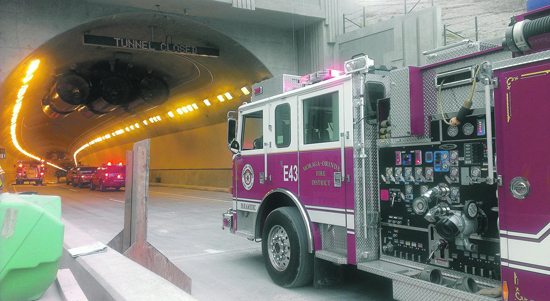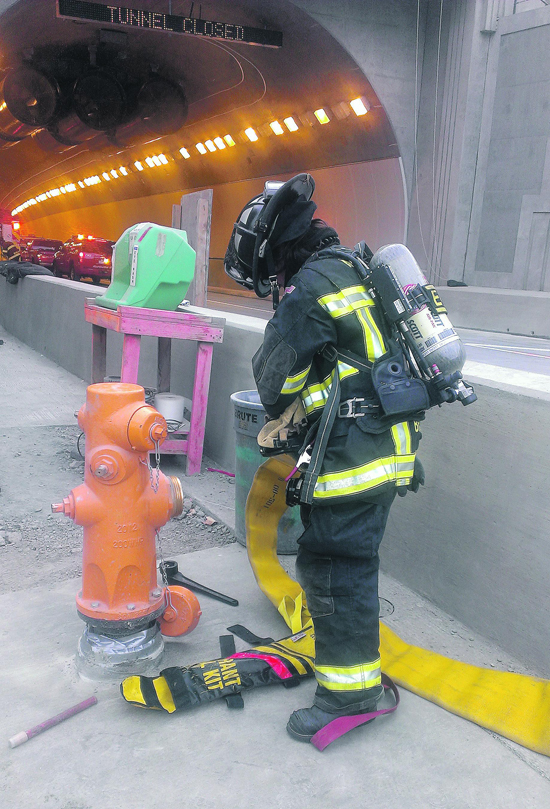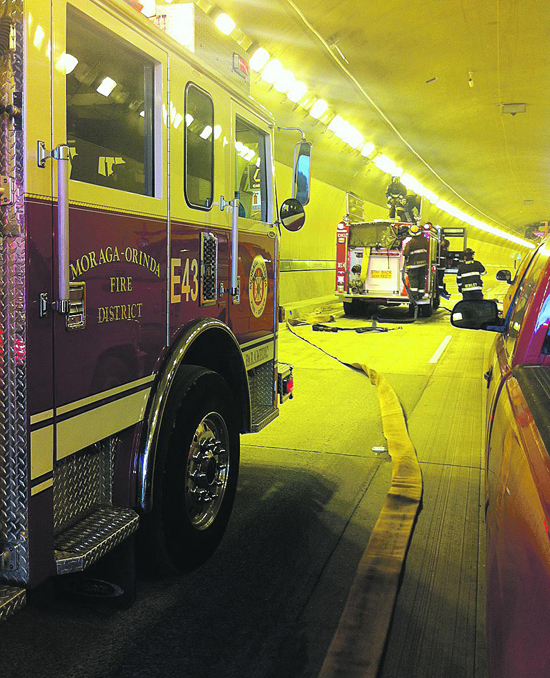 | | | MOFD fire engine at the new bore entrance Photos Nick Marnell
| | | | | | The week before the opening of the Caldecott Tunnel's Fourth Bore, the Moraga-Orinda Fire District, along with other fire agencies, participated in safety drills that simulated events ranging from a car fire to an explosion inside the tunnel. Many of the tests involved upgraded systems requested by the district.
 As MOFD is the first responder on the Orinda side of the tunnel, the California Department of Transportation asked the district what specific safety measures it would like to see implemented in the new bore. The district requested a new and improved water system and an upgraded radio communication system, according to fire chief Stephen Healy.
As MOFD is the first responder on the Orinda side of the tunnel, the California Department of Transportation asked the district what specific safety measures it would like to see implemented in the new bore. The district requested a new and improved water system and an upgraded radio communication system, according to fire chief Stephen Healy.
 Fifty-year-old pipes run water through the system in bores one, two and three; the Fourth Bore uses a looped system, which provides superior water pressure and, during a fire, its cut-off valves can be manipulated so that the water supply may be diverted and concentrated to put the fire out. "We will be upgrading the system on one, two and three," said Caltrans project engineer Byron Lim.
Fifty-year-old pipes run water through the system in bores one, two and three; the Fourth Bore uses a looped system, which provides superior water pressure and, during a fire, its cut-off valves can be manipulated so that the water supply may be diverted and concentrated to put the fire out. "We will be upgrading the system on one, two and three," said Caltrans project engineer Byron Lim.
 MOFD division chief Darrell Lee said that the tunnel's radio system was upgraded from line-of-sight technology to the digital microwave standards of the East Bay Regional Communication System, which is used by public agencies within Alameda and Contra Costa counties. "I can talk to somebody in that tunnel now from my office," said Healy, his office being nearly seven miles from the tunnel entrance.
MOFD division chief Darrell Lee said that the tunnel's radio system was upgraded from line-of-sight technology to the digital microwave standards of the East Bay Regional Communication System, which is used by public agencies within Alameda and Contra Costa counties. "I can talk to somebody in that tunnel now from my office," said Healy, his office being nearly seven miles from the tunnel entrance.
 Many other new fire and safety features were added, including huge, loud jet fans that can replenish fresh air inside the tunnel in minutes. Healy said he was impressed with the installation of new crossing arms in front of bores three and four, which will provide instant closure of the tunnels in case of emergency. The most obvious emergency feature visible to motorists may be the new bore's 10-foot-wide shoulder, large enough to handle a disabled vehicle or an emergency vehicle.
Many other new fire and safety features were added, including huge, loud jet fans that can replenish fresh air inside the tunnel in minutes. Healy said he was impressed with the installation of new crossing arms in front of bores three and four, which will provide instant closure of the tunnels in case of emergency. The most obvious emergency feature visible to motorists may be the new bore's 10-foot-wide shoulder, large enough to handle a disabled vehicle or an emergency vehicle.
 Among the exercises conducted the week of Nov. 11 was a drill involving the new water system. An MOFD firefighter responded to a simulated car fire inside the tunnel, and she connected the engine's hose to one of the two new hydrants outside bore four. But there was uncertainty over which hydrant was associated with which standpipe. A congregation of firefighters, engineers and technicians who witnessed the drill suggested that the pipes be color coded to dispel potential confusion. And by the end of the week, they were. "Blue for high pressure, red for low pressure," said Caltrans engineer Jim Adair.
Among the exercises conducted the week of Nov. 11 was a drill involving the new water system. An MOFD firefighter responded to a simulated car fire inside the tunnel, and she connected the engine's hose to one of the two new hydrants outside bore four. But there was uncertainty over which hydrant was associated with which standpipe. A congregation of firefighters, engineers and technicians who witnessed the drill suggested that the pipes be color coded to dispel potential confusion. And by the end of the week, they were. "Blue for high pressure, red for low pressure," said Caltrans engineer Jim Adair.
 "That's why we go through these exercises," added Lim.
"That's why we go through these exercises," added Lim.
 The fire and safety efforts and traffic management will be coordinated out of a new Operations and Maintenance Control building on the west side of the tunnel. The building will be staffed 24/7 by trained operators who must pass a test administered by the state fire marshal.
The fire and safety efforts and traffic management will be coordinated out of a new Operations and Maintenance Control building on the west side of the tunnel. The building will be staffed 24/7 by trained operators who must pass a test administered by the state fire marshal.
 "It will make it quicker to respond, and for us to send the correct response," said Bijan Sartipi, Caltrans district director.
"It will make it quicker to respond, and for us to send the correct response," said Bijan Sartipi, Caltrans district director.

|


